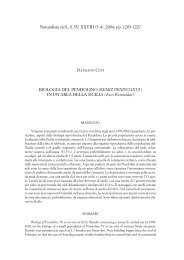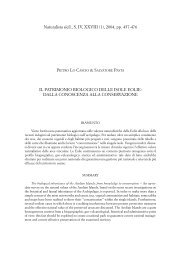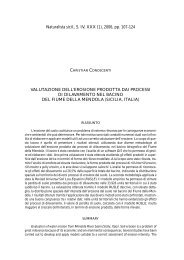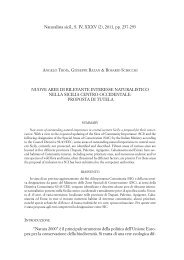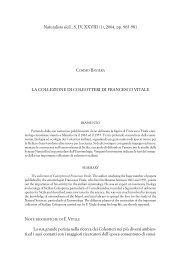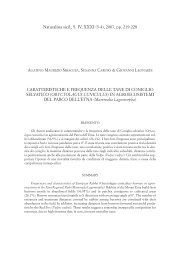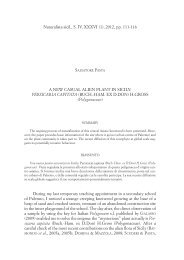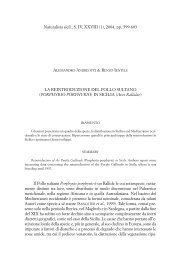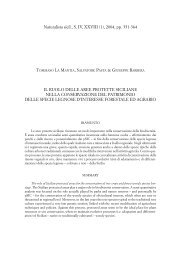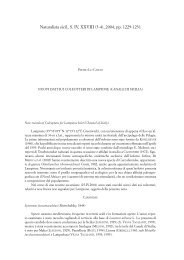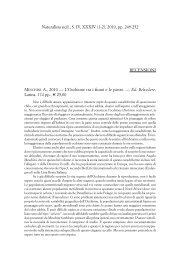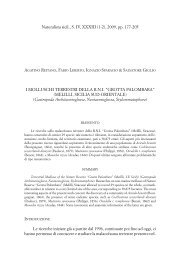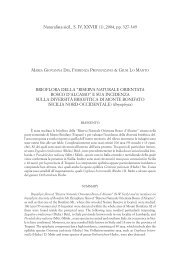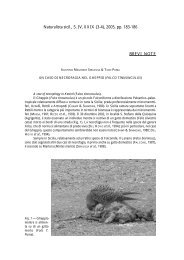2007,pp - Società Siciliana di Scienze Naturali
2007,pp - Società Siciliana di Scienze Naturali
2007,pp - Società Siciliana di Scienze Naturali
You also want an ePaper? Increase the reach of your titles
YUMPU automatically turns print PDFs into web optimized ePapers that Google loves.
280 M. SKUHRAVÁ, V. SKUHRAVY´ & B. MASSA<br />
1905a, 1906c) found galls on Vicia dasycarpa Ten. at “R. Villa Favorita”, Palermo<br />
in April and May, obtaining also some parasitoids. DE STEFANI jr (1942)<br />
reported it also from Lo Zucco (Palermo) in spring. Distribution: Euro-Siberian,<br />
occurring up to Kazakhstan and Turkey (SKUHRAVÁ et al., 2005).<br />
Dicro<strong>di</strong>plosis pseudococci (Felt, 1914)<br />
Larvae prey on Planococcus citri (Hemiptera Pseudococcidae) on Citrus<br />
sp. (Rutaceae). FELT (1914) based its description on the material sent to him<br />
from Sicily. Occurrence: LONGO et al. (2001) report this species from the<br />
Etna region. Reference: SOLINAS (1971) stu<strong>di</strong>ed morphological characters of<br />
larvae. Distribution: Tropical and sub-Tropical species reaching in Sicily the<br />
northern boundary of its <strong>di</strong>stribution area.<br />
Dryomyia circinans (Giraud, 1861)<br />
Larvae cause galls on leaves of Quercus cerris L. and related species<br />
(Fagaceae). Each gall has a densely haired <strong>di</strong>sc on the lower side and a round<br />
opening on the u<strong>pp</strong>er side of the leaf. Occurrence: DE STEFANI (1898d,<br />
1906c) found very abundant galls of this species on Quercus suber L. at<br />
Castelvetrano (Trapani) and later (1907a) reported other Sicilian galls on<br />
Quercus persica Jaulc., host plant originating from Kur<strong>di</strong>stan. Reference:<br />
TROTTER & CECCONI (1900-1917: N. 434), Bosco La Cava sulle Madonie<br />
(Sicily), 1904, leg. Prof. F. Cavara (galls on Quercus suber L.). LONGO et al.<br />
(2001) report this species on Q. ilex from the Etna region. Distribution:<br />
Me<strong>di</strong>terranean; it also occurs in Turkey (SKUHRAVÁ et al., 2005).<br />
Dryomyia lichtensteinii (F. Löw, 1878)<br />
Larvae cause galls on leaves of Quercus ilex L. (Fagaceae), with an egglike<br />
swelling on the lower side, and a slit opening on the u<strong>pp</strong>er side. One generation<br />
develops a year. Larvae hibernate in galls. Occurrence: DE STEFANI<br />
(1906c) recorded it from Sicily; CECCONI (1902) reported galls from Ficuzza,<br />
1876 (leg. Prof. A. Borzì). LONGO et al. (2001) report galls from the Etna<br />
region. It is quite common on Madonie Mts. (up to 1300 m) and Ficuzza (600-<br />
900 m) wood. New records: Castelbuono, loc. Gonato, adults emerged on<br />
1.5.2006 from galls collected 20.4.2006; Ficuzza, 10.5.<strong>2007</strong>, leg. B. Massa.<br />
Distribution: Me<strong>di</strong>terranean.<br />
Feltiella acarisuga (Vallot, 1827)<br />
Syn. Thero<strong>di</strong>plosis persicae Kieffer, 1912<br />
Larvae are zoophagous and prey on red spider mites of the genus<br />
Tetranychus (Acarina Tetranychidae). GAGNÉ (1995) revised the genus<br />
Feltiella and synonymized several species under Feltiella acarisuga (Vallot,



